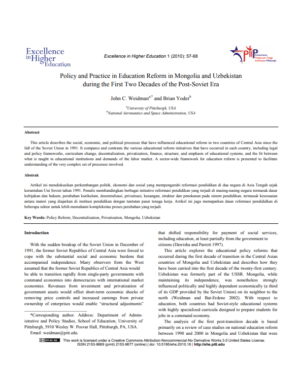
This article describes the social, economic, and political processes that have influenced educational reform in two countries of Central Asia since the fall of the Soviet Union in 1991. It compares and contrasts the various educational reform initiatives that have occurred in each country, including legal and policy frameworks, curriculum change, decentralization, privatization, finance, structure, and emphasis of educational systems, and the fit between what is taught in educational institutions and demands of the labor market. A sector-wide framework for education reform is presented to facilitate understanding of the very complex set of processes involved.
Author(s): J. Weidman and B. Yoder
Year Published: 2010
Language: English
Country: Mongolia, Uzbekistan, United States of America


